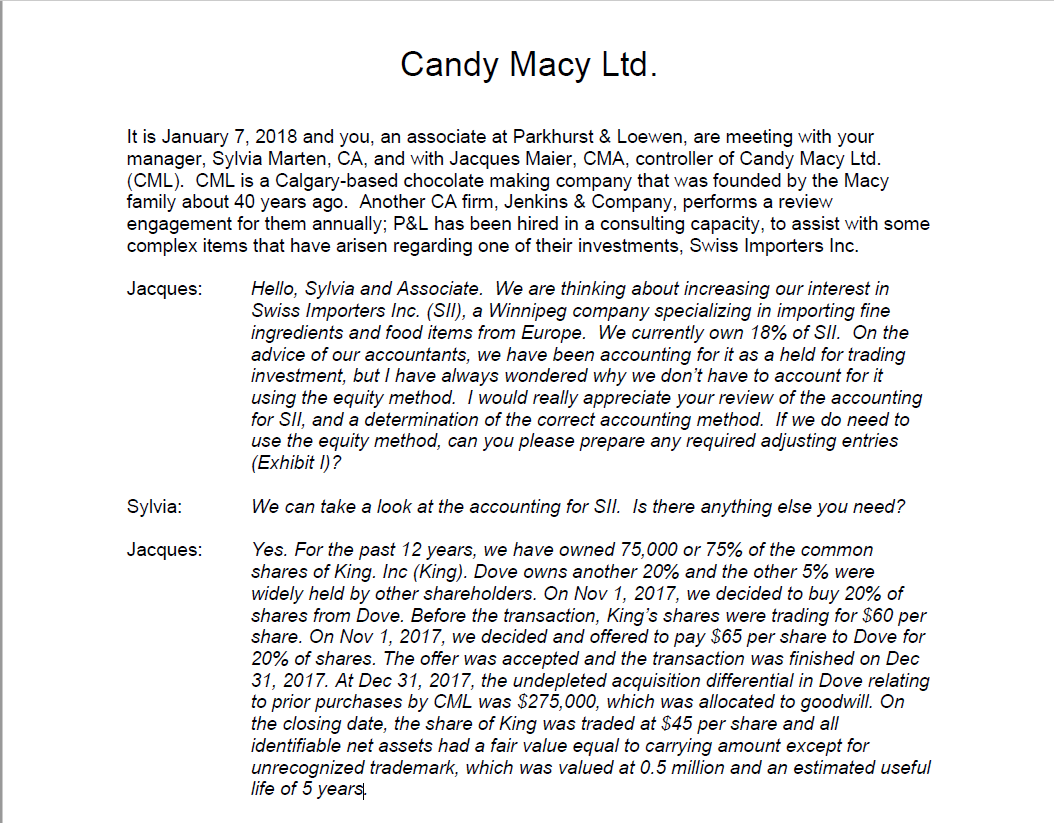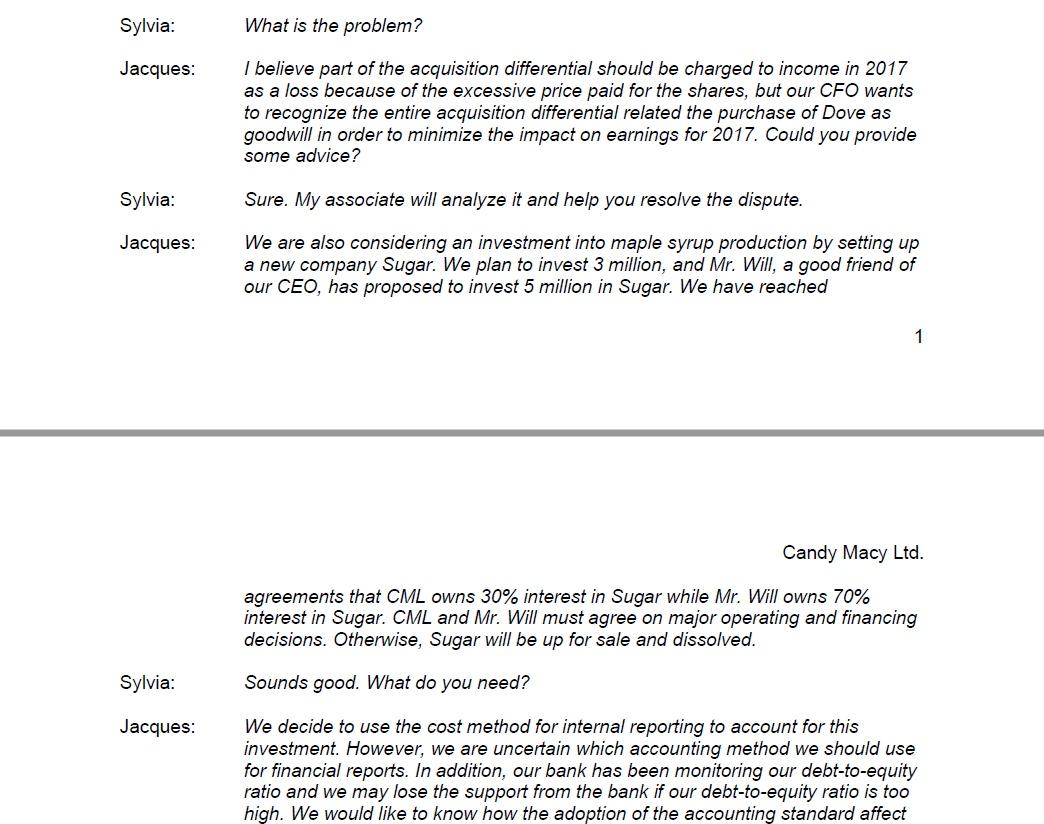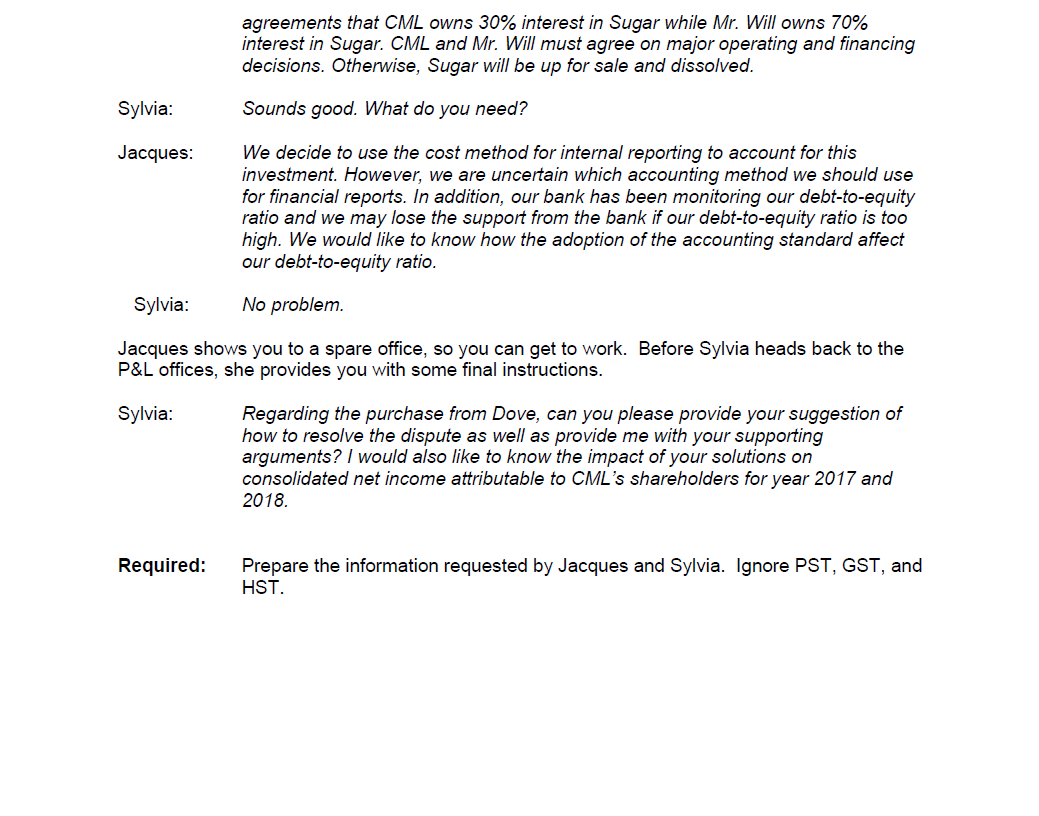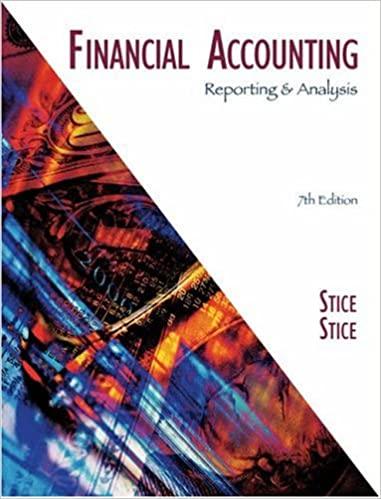






Candy Macy Ltd. It is January 7, 2018 and you, an associate at Parkhurst & Loewen, are meeting with your manager, Sylvia Marten, CA, and with Jacques Maier, CMA, controller of Candy Macy Ltd. (CML). CML is a Calgary-based chocolate making company that was founded by the Macy family about 40 years ago. Another CA firm, Jenkins & Company, performs a review engagement for them annually; P&L has been hired in a consulting capacity, to assist with some complex items that have arisen regarding one of their investments, Swiss Importers Inc. Jacques: Hello, Sylvia and Associate. We are thinking about increasing our interest in Swiss Importers Inc. (SII), a Winnipeg company specializing in importing fine ingredients and food items from Europe. We currently own 18% of SII. On the advice of our accountants, we have been accounting for it as a held for trading investment, but I have always wondered why we don't have to account for it using the equity method. I would really appreciate your review of the accounting for SII, and a determination of the correct accounting method. If we do need to use the equity method, can you please prepare any required adjusting entries (Exhibit 1)? Sylvia: We can take a look at the accounting for Sil. Is there anything else you need? Jacques: Yes. For the past 12 years, we have owned 75,000 or 75% of the common shares of King. Inc (King). Dove owns another 20% and the other 5% were widely held by other shareholders. On Nov 1, 2017, we decided to buy 20% of shares from Dove. Before the transaction, King's shares were trading for $60 per share. On Nov 1, 2017, we decided and offered to pay $65 per share to Dove for 20% of shares. The offer was accepted and the transaction was finished on Dec 31, 2017. At Dec 31, 2017, the undepleted acquisition differential in Dove relating to prior purchases by CML was $275,000, which was allocated to goodwill. On the closing date, the share of King was traded at $45 per share and all identifiable net assets had a fair value equal to carrying amount except for unrecognized trademark, which was valued at 0.5 million and an estimated useful life of 5 yearst Sylvia: What is the problem? Jacques: I believe part of the acquisition differential should be charged to income in 2017 as a loss because of the excessive price paid for the shares, but our CFO wants to recognize the entire acquisition differential related the purchase of Dove as goodwill in order to minimize the impact on earnings for 2017. Could you provide some advice? Sylvia: Sure. My associate will analyze it and help you resolve the dispute. Jacques: We are also considering an investment into maple syrup production by setting up a new company Sugar. We plan to invest 3 million, and Mr. Will, a good friend of our CEO, has proposed to invest 5 million in Sugar. We have reached 1 Candy Macy Ltd. agreements that CML owns 30% interest in Sugar while Mr. Will owns 70% interest in Sugar. CML and Mr. Will must agree on major operating and financing decisions. Otherwise, Sugar will be up for sale and dissolved. Sylvia: Sounds good. What do you need? Jacques: We decide to use the cost method for internal reporting to account for this investment. However, we are uncertain which accounting method we should use for financial reports. In addition, our bank has been monitoring our debt-to-equity ratio and we may lose the support from the bank if our debt-to-equity ratio is too high. We would like to know how the adoption of the accounting standard affect agreements that CML owns 30% interest in Sugar while Mr. Will owns 70% interest in Sugar. CML and Mr. Will must agree on major operating and financing decisions. Otherwise, Sugar will be up for sale and dissolved. Sylvia: Sounds good. What do you need? Jacques: We decide to use the cost method for internal reporting to account for this investment. However, we are uncertain which accounting method we should use for financial reports. In addition, our bank has been monitoring our debt-to-equity ratio and we may lose the support from the bank if our debt-to-equity ratio is too high. We would like to know how the adoption of the accounting standard affect our debt-to-equity ratio. Sylvia: No problem. Jacques shows you to a spare office, so you can get to work. Before Sylvia heads back to the P&L offices, she provides you with some final instructions. Sylvia: Regarding the purchase from Dove, can you please provide your suggestion of how to resolve the dispute as well as provide me with your supporting arguments? I would also like to know the impact of your solutions on consolidated net income attributable to CML's shareholders for year 2017 and 2018. Required: Prepare the information requested by Jacques and Sylvia. Ignore PST, GST, and HST. Candy Macy Ltd. Exhibit Information Regarding Swiss Importers Inc. (Prepared by Jacques Maier, Controller) Initial investment On October 1, 2012, we acquired 18% of Swiss Importers Inc. (which is headquartered in Winnipeg) for $450,000. As our investment in Sil is accounted for as a held for trading investment, we mark it to market on each balance sheet date. On September 30, 2017, SII was recorded on our books at $500,000. I sit on the Sll board of directors, and we occasionally sell inventory back and forth, particularly at Christmas time. I found the following calculation in my predecessor's records from 2012: $ 450,000 2,000 350,000 98,000 Cost of investment CML's share of book value of common stock acquired CML's share of book value of retained earnings acquired Purchase premium Fair value differentials on CML's share Inventory Equipment (remaining useful life: 10 years) Goodwill (8,000) (40,000) $ 50,000 Summary financial statement information - Balance sheets as at September 30 Cash Accounts receivable Inventory PPE 2017 $ 10,000 188,670 245,960 2,768,000 $ 3,212,630 2016 $ 85,000 235,460 201,890 2,242,500 $ 2,764,850 2015 $ 80,000 189,500 181,600 2,200,600 $ 2,651,700 Accounts payable $ 417,000 $ 315,870 $ 347,310 $ 315,870 $ 347,310 75,000 Accounts payable Dividends payable Bank loan Deferred income taxes Liabilities $ 417,000 50,000 500,000 36,000 1,003,000 200,000 36,000 551,870 29.000 451,310 Common shares Retained earnings Equity Total liabilities and equity 10,000 2,199,630 2,209,630 $ 3.212.630 10,000 2,202,980 2,212,980 $ 2,764,850 10,000 2.190,390 2,200,390 $ 2,651,700 3 Candy Macy Ltd. Exhibit I (continued) Information Regarding Swiss Importers Inc. (Prepared by Jacques Maier, Controller) Summary financial statement information - Income statements for the years ended September 30 Candy Macy Ltd. Exhibit I (continued) Information Regarding Swiss Importers Inc. (Prepared by Jacques Maier, Controller) Summary financial statement information - Income statements for the years ended September 30 Sales Cost of sales Gross margin 2017 $ 2,395,000 1,614,650 780,350 2016 $ 2,667,800 1,728,500 939,300 2015 $ 2,156,500 1,374,720 781,780 98,990 72,300 15,400 Amortization Interest Professional fees Rent and occupancy Repairs and maintenance Selling and administration Loss on sale of asset * 95,710 16,000 6,000 160,000 8,000 270,000 220,000 29,000 150,000 5,000 491,700 5,500 160,000 12,000 216,000 555,710 492,490 Net income before taxes Taxes 288,650 42,000 383,590 71,000 289,290 55,000 Net income Opening retained earnings Dividends ** Ending retained earnings $ 246,650 2,202,980 (250,000) $ 2,199,630 $ 312,590 2,190,390 (300,000) $ 2,202,980 $ 234,290 2,181,100 (225,000) $ 2,190,390 Cost of sales Gross margin 1,614,650 780,350 1,728,500 939,300 1,374,720 781,780 98,990 72,300 15,400 Amortization Interest Professional fees Rent and occupancy Repairs and maintenance Selling and administration Loss on sale of asset * 95,710 16,000 6,000 160,000 8,000 270,000 220,000 29,000 150,000 5,000 491,700 5,500 160,000 12,000 216,000 555,710 492,490 Net income before taxes Taxes 288,650 42,000 383,590 71,000 289,290 55,000 Net income Opening retained earnings Dividends ** Ending retained earnings $ 246,650 2,202,980 (250,000) $ 2,199,630 $ 312,590 2,190,390 (300,000) $ 2,202,980 $ 234,290 2,181,100 (225,000) $ 2,190,390 * SII sold one of the pieces of equipment that existed at acquisition at a loss of $5,000. On October 1, 2012, this equipment had a book value of $35,000 and fair value of $45,000. ** SII did not receive a dividend refund in 2017. CML's current year non-consolidated income statement includes $40,000 of dividends received from SII. Candy Macy Ltd. It is January 7, 2018 and you, an associate at Parkhurst & Loewen, are meeting with your manager, Sylvia Marten, CA, and with Jacques Maier, CMA, controller of Candy Macy Ltd. (CML). CML is a Calgary-based chocolate making company that was founded by the Macy family about 40 years ago. Another CA firm, Jenkins & Company, performs a review engagement for them annually; P&L has been hired in a consulting capacity, to assist with some complex items that have arisen regarding one of their investments, Swiss Importers Inc. Jacques: Hello, Sylvia and Associate. We are thinking about increasing our interest in Swiss Importers Inc. (SII), a Winnipeg company specializing in importing fine ingredients and food items from Europe. We currently own 18% of SII. On the advice of our accountants, we have been accounting for it as a held for trading investment, but I have always wondered why we don't have to account for it using the equity method. I would really appreciate your review of the accounting for SII, and a determination of the correct accounting method. If we do need to use the equity method, can you please prepare any required adjusting entries (Exhibit 1)? Sylvia: We can take a look at the accounting for Sil. Is there anything else you need? Jacques: Yes. For the past 12 years, we have owned 75,000 or 75% of the common shares of King. Inc (King). Dove owns another 20% and the other 5% were widely held by other shareholders. On Nov 1, 2017, we decided to buy 20% of shares from Dove. Before the transaction, King's shares were trading for $60 per share. On Nov 1, 2017, we decided and offered to pay $65 per share to Dove for 20% of shares. The offer was accepted and the transaction was finished on Dec 31, 2017. At Dec 31, 2017, the undepleted acquisition differential in Dove relating to prior purchases by CML was $275,000, which was allocated to goodwill. On the closing date, the share of King was traded at $45 per share and all identifiable net assets had a fair value equal to carrying amount except for unrecognized trademark, which was valued at 0.5 million and an estimated useful life of 5 yearst Sylvia: What is the problem? Jacques: I believe part of the acquisition differential should be charged to income in 2017 as a loss because of the excessive price paid for the shares, but our CFO wants to recognize the entire acquisition differential related the purchase of Dove as goodwill in order to minimize the impact on earnings for 2017. Could you provide some advice? Sylvia: Sure. My associate will analyze it and help you resolve the dispute. Jacques: We are also considering an investment into maple syrup production by setting up a new company Sugar. We plan to invest 3 million, and Mr. Will, a good friend of our CEO, has proposed to invest 5 million in Sugar. We have reached 1 Candy Macy Ltd. agreements that CML owns 30% interest in Sugar while Mr. Will owns 70% interest in Sugar. CML and Mr. Will must agree on major operating and financing decisions. Otherwise, Sugar will be up for sale and dissolved. Sylvia: Sounds good. What do you need? Jacques: We decide to use the cost method for internal reporting to account for this investment. However, we are uncertain which accounting method we should use for financial reports. In addition, our bank has been monitoring our debt-to-equity ratio and we may lose the support from the bank if our debt-to-equity ratio is too high. We would like to know how the adoption of the accounting standard affect agreements that CML owns 30% interest in Sugar while Mr. Will owns 70% interest in Sugar. CML and Mr. Will must agree on major operating and financing decisions. Otherwise, Sugar will be up for sale and dissolved. Sylvia: Sounds good. What do you need? Jacques: We decide to use the cost method for internal reporting to account for this investment. However, we are uncertain which accounting method we should use for financial reports. In addition, our bank has been monitoring our debt-to-equity ratio and we may lose the support from the bank if our debt-to-equity ratio is too high. We would like to know how the adoption of the accounting standard affect our debt-to-equity ratio. Sylvia: No problem. Jacques shows you to a spare office, so you can get to work. Before Sylvia heads back to the P&L offices, she provides you with some final instructions. Sylvia: Regarding the purchase from Dove, can you please provide your suggestion of how to resolve the dispute as well as provide me with your supporting arguments? I would also like to know the impact of your solutions on consolidated net income attributable to CML's shareholders for year 2017 and 2018. Required: Prepare the information requested by Jacques and Sylvia. Ignore PST, GST, and HST. Candy Macy Ltd. Exhibit Information Regarding Swiss Importers Inc. (Prepared by Jacques Maier, Controller) Initial investment On October 1, 2012, we acquired 18% of Swiss Importers Inc. (which is headquartered in Winnipeg) for $450,000. As our investment in Sil is accounted for as a held for trading investment, we mark it to market on each balance sheet date. On September 30, 2017, SII was recorded on our books at $500,000. I sit on the Sll board of directors, and we occasionally sell inventory back and forth, particularly at Christmas time. I found the following calculation in my predecessor's records from 2012: $ 450,000 2,000 350,000 98,000 Cost of investment CML's share of book value of common stock acquired CML's share of book value of retained earnings acquired Purchase premium Fair value differentials on CML's share Inventory Equipment (remaining useful life: 10 years) Goodwill (8,000) (40,000) $ 50,000 Summary financial statement information - Balance sheets as at September 30 Cash Accounts receivable Inventory PPE 2017 $ 10,000 188,670 245,960 2,768,000 $ 3,212,630 2016 $ 85,000 235,460 201,890 2,242,500 $ 2,764,850 2015 $ 80,000 189,500 181,600 2,200,600 $ 2,651,700 Accounts payable $ 417,000 $ 315,870 $ 347,310 $ 315,870 $ 347,310 75,000 Accounts payable Dividends payable Bank loan Deferred income taxes Liabilities $ 417,000 50,000 500,000 36,000 1,003,000 200,000 36,000 551,870 29.000 451,310 Common shares Retained earnings Equity Total liabilities and equity 10,000 2,199,630 2,209,630 $ 3.212.630 10,000 2,202,980 2,212,980 $ 2,764,850 10,000 2.190,390 2,200,390 $ 2,651,700 3 Candy Macy Ltd. Exhibit I (continued) Information Regarding Swiss Importers Inc. (Prepared by Jacques Maier, Controller) Summary financial statement information - Income statements for the years ended September 30 Candy Macy Ltd. Exhibit I (continued) Information Regarding Swiss Importers Inc. (Prepared by Jacques Maier, Controller) Summary financial statement information - Income statements for the years ended September 30 Sales Cost of sales Gross margin 2017 $ 2,395,000 1,614,650 780,350 2016 $ 2,667,800 1,728,500 939,300 2015 $ 2,156,500 1,374,720 781,780 98,990 72,300 15,400 Amortization Interest Professional fees Rent and occupancy Repairs and maintenance Selling and administration Loss on sale of asset * 95,710 16,000 6,000 160,000 8,000 270,000 220,000 29,000 150,000 5,000 491,700 5,500 160,000 12,000 216,000 555,710 492,490 Net income before taxes Taxes 288,650 42,000 383,590 71,000 289,290 55,000 Net income Opening retained earnings Dividends ** Ending retained earnings $ 246,650 2,202,980 (250,000) $ 2,199,630 $ 312,590 2,190,390 (300,000) $ 2,202,980 $ 234,290 2,181,100 (225,000) $ 2,190,390 Cost of sales Gross margin 1,614,650 780,350 1,728,500 939,300 1,374,720 781,780 98,990 72,300 15,400 Amortization Interest Professional fees Rent and occupancy Repairs and maintenance Selling and administration Loss on sale of asset * 95,710 16,000 6,000 160,000 8,000 270,000 220,000 29,000 150,000 5,000 491,700 5,500 160,000 12,000 216,000 555,710 492,490 Net income before taxes Taxes 288,650 42,000 383,590 71,000 289,290 55,000 Net income Opening retained earnings Dividends ** Ending retained earnings $ 246,650 2,202,980 (250,000) $ 2,199,630 $ 312,590 2,190,390 (300,000) $ 2,202,980 $ 234,290 2,181,100 (225,000) $ 2,190,390 * SII sold one of the pieces of equipment that existed at acquisition at a loss of $5,000. On October 1, 2012, this equipment had a book value of $35,000 and fair value of $45,000. ** SII did not receive a dividend refund in 2017. CML's current year non-consolidated income statement includes $40,000 of dividends received from SII













